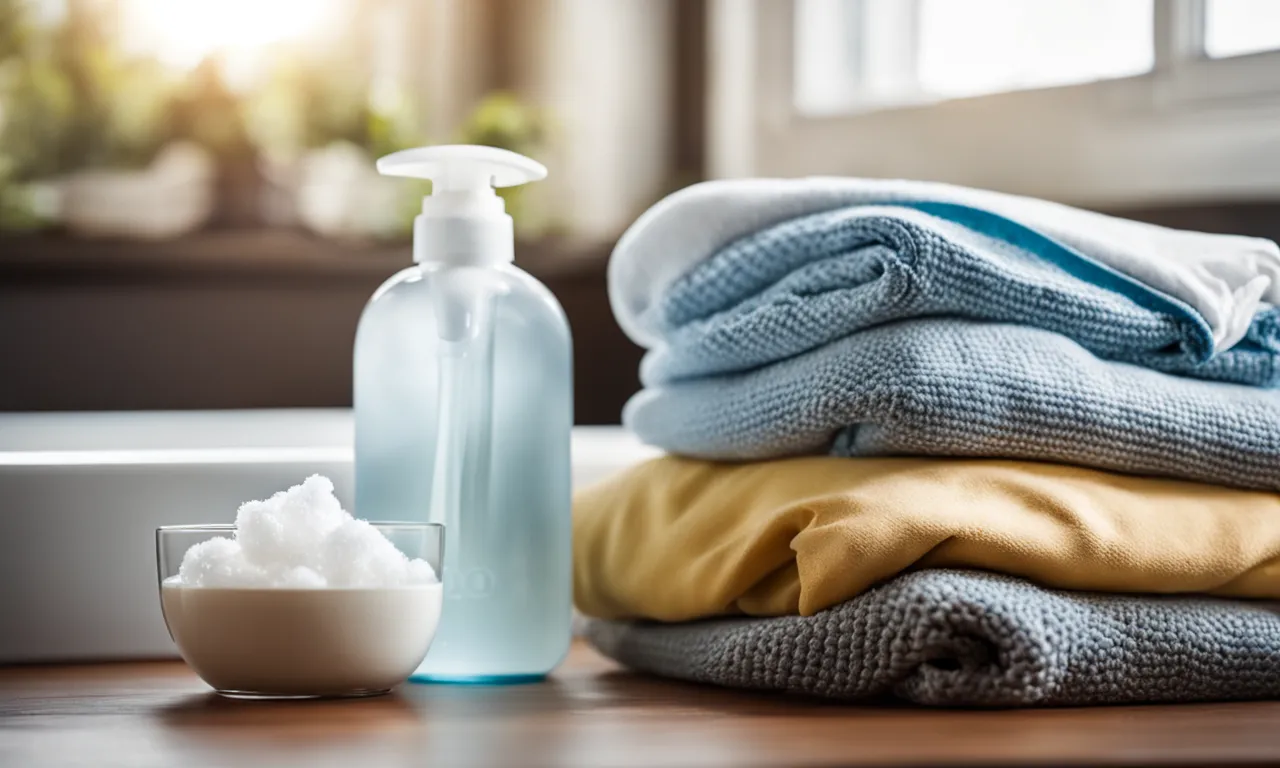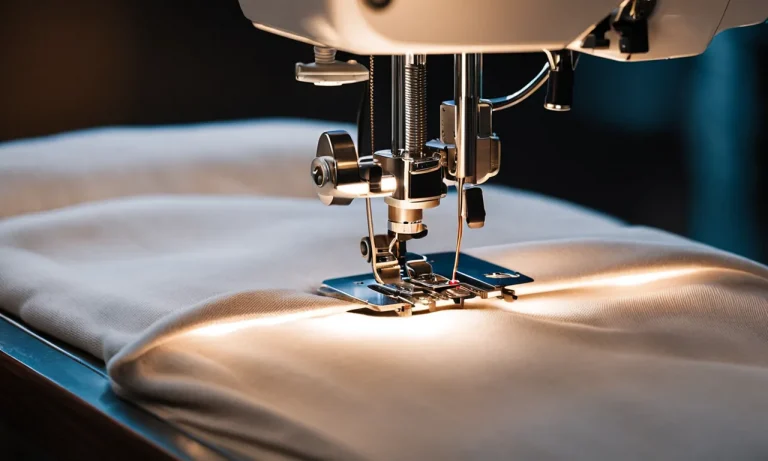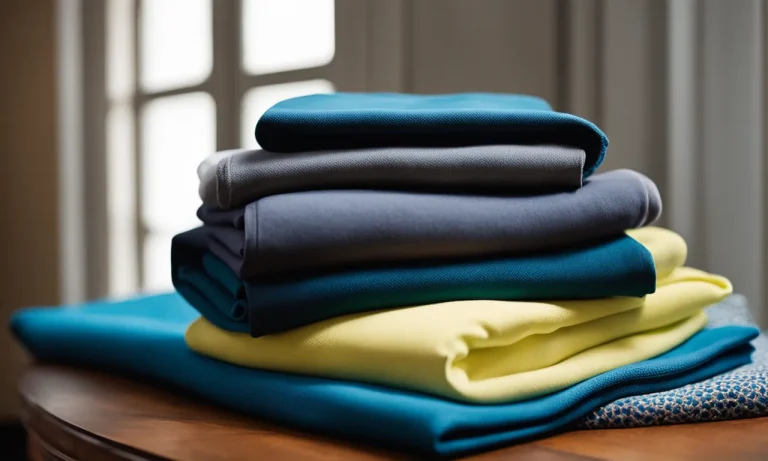Can You Pour Fabric Softener Directly On Clothes?
Doing laundry can be a tedious chore. We all want our clothes to come out of the wash soft, fresh, and static-free. But who has time to wait for the rinse cycle to add a liquid fabric softener? If you’re short on time, here’s a quick answer to your question: No, you should not pour liquid fabric softener directly onto clothes.
Read on to learn why this is not recommended along with tips for proper fabric softener use.
In this comprehensive guide, we’ll cover everything you need to know about the do’s and don’ts of using liquid fabric softener. You’ll learn when and how to use fabric softener properly so your laundry comes out soft, fresh, and static-free every time.
What is Fabric Softener?
Fabric softener is a laundry product that is designed to enhance the softness of fabrics and reduce static cling. It is commonly used in the final rinse cycle of a washing machine or during the drying process.
Fabric softener works by coating the fibers of the fabric, making them feel smoother and more comfortable against the skin.
Designed to Make Fabrics Soft and Reduce Static
The primary purpose of fabric softener is to make clothes and other fabrics feel softer and more luxurious. When used correctly, fabric softener can make even rough fabrics feel smoother and more comfortable to wear.
This is especially beneficial for items like towels and bedding, which come into direct contact with the skin.
Additionally, fabric softener helps to reduce static cling, which can be a common problem, especially in dry climates. By coating the fabric fibers with a thin layer of softening agents, fabric softener helps prevent the build-up of static electricity, resulting in less clinging, sticking, and annoying shocks.
Comes in Liquid and Dryer Sheet Forms
Fabric softener is available in two main forms: liquid and dryer sheets. Liquid fabric softener is typically added to the final rinse cycle of a washing machine. It is diluted with water and distributed evenly throughout the load, ensuring that all fabrics receive the softening benefits.
Dryer sheets, on the other hand, are single-use sheets that are added to the dryer along with the wet clothes. As the dryer heats up, the heat activates the softening agents in the sheet, which are then transferred to the fabrics, providing a similar softening effect as liquid fabric softener.
Both liquid fabric softener and dryer sheets are widely available in stores and can be used with most types of clothing and fabrics. However, it’s important to follow the instructions on the packaging to ensure the correct amount is used for each load and to avoid any potential staining or residue.
For more information on fabric softener and its proper usage, you can visit Cleanipedia, a trusted source for laundry tips and advice.
Benefits of Using Fabric Softener
Leaves Clothes Feeling Soft
One of the key benefits of using fabric softener is that it leaves your clothes feeling incredibly soft. The softening agents in fabric softeners work by coating the fibers of the fabric, resulting in a smoother texture.
This not only enhances the comfort of your clothes, but it also helps to reduce friction, making them less likely to cause irritation or chafing on your skin. So, if you want to enjoy the luxurious feeling of soft and velvety clothes, using fabric softener is a great option.
Eliminates Static Cling
Static cling can be a real annoyance, especially during the colder months. However, fabric softener can come to the rescue! By reducing the friction between clothes, fabric softeners help to eliminate static cling.
This means that your clothes will no longer cling to your body or each other, making them much easier to wear and manage. Say goodbye to embarrassing skirt sticking to tights moments or shirts that constantly cling to your body. Fabric softener is the solution to keep your clothes static-free!
Provides a Fresh Scent
Who doesn’t love the smell of freshly laundered clothes? Fabric softeners not only soften your clothes but also infuse them with a delightful fragrance. The pleasant scents can range from floral to fruity to clean and refreshing, leaving your clothes smelling amazing.
Not only will you feel great while wearing your clothes, but you’ll also enjoy the compliments you receive on how good you smell. So, if you want your clothes to have a long-lasting, pleasant scent, using fabric softener is a must.
When it comes to fabric softeners, it’s important to choose the right one for your needs. Some fabric softeners are designed for use in the washing machine, while others are specifically made for use in the dryer.
Additionally, there are also fabric softener sheets that can be added to the dryer or used as a static eliminator on clothes. Remember to follow the instructions on the packaging to ensure proper usage and to achieve the desired results.
For more information on fabric softeners and their benefits, you can visit websites like The Spruce or Cleanipedia.
When to Add Fabric Softener
Fabric softener is a popular laundry product that helps to make clothes feel softer, reduce static cling, and add a pleasant scent. But when exactly should you add fabric softener to your laundry? There are two main options: during the rinse cycle or in the dryer with dryer sheets.
During the Rinse Cycle
One common way to add fabric softener is during the rinse cycle of your washing machine. This is typically done by using a fabric softener dispenser or by manually pouring the softener into the designated compartment in your machine.
When added during the rinse cycle, the fabric softener is evenly distributed and thoroughly absorbed by the clothes, resulting in softer and more static-free garments.
Adding fabric softener during the rinse cycle is especially beneficial for fabrics that tend to be rough or stiff, such as towels or bedding. It can also be a great option for people with sensitive skin, as it helps to reduce any potential irritation caused by harsh fabrics.
In the Dryer with Dryer Sheets
Another option for adding fabric softener is by using dryer sheets. These are small sheets that are coated with fabric softener and are placed in the dryer along with your laundry. As the dryer heats up, the fabric softener is released from the sheets and coats the clothes, leaving them feeling soft and smelling fresh.
Dryer sheets are particularly convenient for those who don’t have a fabric softener dispenser in their washing machine or prefer not to use liquid fabric softener. They are also a great option for those who want to add fabric softener to specific items of clothing rather than the entire load.
It’s important to note that using fabric softener in the dryer with dryer sheets may not provide the same level of softness and scent as adding it during the rinse cycle. However, it can still help to reduce static cling and make your clothes feel more comfortable to wear.
Ultimately, the choice of when to add fabric softener depends on your personal preference and the specific needs of your laundry. So go ahead and experiment with both methods to find the one that works best for you and your clothes!
Why You Shouldn’t Pour it Directly on Clothes
While it may seem convenient to pour fabric softener directly onto your clothes, it’s actually not a recommended practice. Here’s why:
Can Cause Buildup on Fabrics
Pouring fabric softener directly on clothes can lead to a buildup of the product on the fabric. Over time, this can create a residue that makes clothes feel stiff and less comfortable to wear. Additionally, the buildup can attract dirt and grime, causing clothes to become dingy and lose their vibrancy.
Spots and Stains
Directly pouring fabric softener onto clothes can also result in spots and stains. This is especially true for concentrated fabric softeners, as they can leave behind undiluted droplets that may not fully dissolve during the wash cycle.
These undiluted droplets can leave visible marks on clothes, which can be difficult to remove.
Reduced Absorbency
Fabric softeners are designed to coat the fibers of the fabric, which can reduce their absorbency. This can be problematic for items like towels, which rely on absorbency to effectively dry surfaces. When fabric softener is poured directly onto towels, it can leave behind a residue that hampers their ability to absorb moisture.
Void Warranties on Towels and Athletic Wear
Many towel and athletic wear manufacturers recommend avoiding the use of fabric softeners altogether. Some warranties even explicitly state that using fabric softeners will void the warranty. This is because fabric softeners can impact the performance and longevity of these specific types of fabrics.
It’s best to follow the manufacturer’s instructions and add fabric softener to the designated dispenser in your washing machine. This allows the fabric softener to be properly diluted and evenly distributed throughout the wash cycle, resulting in softer, fresher-smelling clothes without the negative side effects.
How to Use Liquid Fabric Softener Properly
Using liquid fabric softener can be a great way to make your clothes feel softer and smell fresher. However, it’s important to know how to use it properly to get the best results. Here are some tips on how to use liquid fabric softener effectively:
Add to Dispenser During Rinse Cycle
The most common and convenient way to use liquid fabric softener is to add it to the dispenser in your washing machine during the rinse cycle. This allows the softener to be evenly distributed throughout the load, resulting in softer clothes.
Simply follow the instructions on the bottle to determine the correct amount to use for your load size.
Dilute with Water First
If you prefer a milder scent or if you have sensitive skin, you can dilute the liquid fabric softener with water before adding it to the dispenser. This will help to reduce the concentration of the softener and make it gentler on your clothes and skin.
To do this, mix one part fabric softener with three parts water and then add it to the dispenser as usual.
Use Amount Recommended on Bottle
It’s important to follow the instructions on the bottle of liquid fabric softener and use the recommended amount for each load. Using too much fabric softener can leave a residue on your clothes, making them feel sticky or greasy.
On the other hand, using too little may not provide the desired softness and scent. So, make sure to measure the fabric softener carefully to achieve the best results.
Remember, using liquid fabric softener can enhance the softness and fragrance of your clothes, but it’s essential to use it correctly. By adding it to the dispenser during the rinse cycle, diluting it with water if necessary, and using the recommended amount, you can enjoy the benefits of fabric softener without any drawbacks.
Happy laundering!
Alternatives to Liquid Fabric Softener
Dryer Sheets
Are you looking for an alternative to liquid fabric softener? Look no further than dryer sheets! These handy sheets are designed to be tossed into the dryer along with your clothes, where they release a thin layer of fabric softener that helps reduce static cling and leaves your clothes feeling soft and smelling fresh.
Dryer sheets are convenient, easy to use, and can be found in most grocery stores. Simply toss one or two sheets into the dryer, and let them work their magic. Plus, they come in a variety of scents, so you can choose the one that suits your preferences.
Try using dryer sheets and say goodbye to static cling!
Add Vinegar to the Rinse Cycle
Another alternative to liquid fabric softener is adding vinegar to the rinse cycle of your washing machine. Vinegar is a natural fabric softener that helps remove detergent residue, reduces static cling, and leaves your clothes feeling soft.
Simply pour a cup of white vinegar into the fabric softener dispenser or directly into the rinse cycle. The vinegar will not only soften your clothes but also help remove any odors. Don’t worry, the smell of vinegar will dissipate during the rinse cycle, leaving your clothes fresh and soft.
Give vinegar a try and see the difference it can make for your laundry!
Use Wool Dryer Balls
If you prefer a more eco-friendly option, consider using wool dryer balls as an alternative to liquid fabric softener. These balls are made from natural materials and can be reused for many cycles, making them a cost-effective choice.
Simply toss a few wool dryer balls into the dryer along with your clothes, and they will help reduce static cling, soften fabrics, and decrease drying time. The balls work by creating space between the clothes, allowing air to circulate more efficiently.
This helps to prevent wrinkles and allows your clothes to dry faster. Plus, you can add a few drops of essential oil to the dryer balls to add a subtle fragrance to your laundry. Give wool dryer balls a try and enjoy softer, static-free clothes!
Sources:
– “Dryer Sheets vs. Liquid Fabric Softener,” Tide
– “Using Vinegar as a Fabric Softener,” The Spruce
– “Wool Dryer Balls: How to Use Them and Why You Should,” Better Homes & Gardens
Laundry Tips for Soft Fabrics
Wash Clothes in Cold Water
When it comes to keeping your fabrics soft, the temperature at which you wash your clothes plays a crucial role. Washing your clothes in cold water can help preserve the softness of the fabric. Hot water can cause fabrics to shrink and become rough, while cold water keeps them soft and supple.
Additionally, cold water is more energy-efficient, saving you money on your utility bills. So, the next time you do your laundry, opt for cold water to ensure your fabrics stay soft and cozy.
Don’t Overload the Washer
While it may be tempting to stuff as many clothes as possible into your washing machine to save time, overloading the washer can actually have a negative impact on the softness of your fabrics. When clothes are crammed together, they don’t have enough space to move around and agitate properly, resulting in less effective cleaning and potential damage to the fabric.
To maintain the softness of your fabrics, it’s best to follow the manufacturer’s recommendation for load sizes and avoid overloading your washer.
Shake Out Clothes After Cycle Ends
After the washing cycle is complete, it’s important to shake out your clothes before transferring them to the dryer. This simple step helps to prevent fabrics from clumping together, which can lead to stiffness.
By giving your clothes a gentle shake, you allow them to separate and air out, promoting a softer texture. So, take a few extra moments to shake out your clothes before drying them, and you’ll be rewarded with beautifully soft garments.
Conclusion
Hopefully this guide has helped explain why pouring liquid fabric softener directly onto your clothes is not recommended. Following the proper usage instructions ensures your laundry comes out soft, fresh, and static-free.
Take the extra minute to add your fabric softener to the dispenser during the rinse cycle and you’ll be rewarded with laundry that feels great. For convenience, dryer sheets or wool balls are great alternatives. With these fabric softener tips, you’ll make laundry day a breeze.







